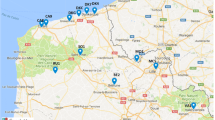Abstract
In this paper, we assess the status of the air quality in the Lake Baikal region which is strongly influenced by the presence of anthropogenic pollution sources. We combined the local data, with global databases, remote sensing imagery and modelling tools. This approach allows to inventorise the air-polluting sources and to quantify the air-quality concentration levels in the Lake Baikal region to a reasonable level, despite the fact that local data are scarcely available. In the simulations, we focus on the month of July 2003, as for this period, validation data are available for a number of ground-based measurement stations within the Lake Baikal region.
Similar content being viewed by others
References
Brutsaert, W. (1975). The roughness length for water vapour, sensible heat, and other scalars. Journal of the Atmospheric Sciences, 32, 2028–2031. doi:10.1175/1520-0469(1975)032<2029:TRLFWV>2.0.CO;2.
Calvert, J. G., Su, F., Bottenheim, J. W., & Strausz, O. P. (1978). Mechanism of the homogeneous oxidation of sulfur dioxide in the troposphere. Atmospheric Environment, 12, 197–226.
Cofala, J., Amann, M., & Mechler, R. (2005). Scenarios of world anthropogenic emissions of air pollutants and methane up to 2030. Report of the Transboundary Air Pollution (TAP) programme, International Institute for Applied Systems Analysis, Laxenburg, Austria.
De Leeuw, F. A. A. M., Rheineck Leyssius, H. J., & Builtjes, P. J. H. (1990). Calculation of long term averaged ground level ozone concentrations. Atmospheric Environment, 241, 185–193.
De Ridder, K. (2006). Testing Brutsaert’s temperature roughness parameterization for representing urban surfaces in atmospheric models. Geophysical Research Letters, 33, L13403. doi:10.1029/2006GL026572.
De Ridder, K., Lefebre, F., Adriaensen, S., Arnold, U., Beckroege, W., Bronner, C., et al (2008). Simulating the impact of urban sprawl on air quality and population exposure in the German Ruhr area. Part II: Development and evaluation of an urban growth scenario. Atmospheric Environment, 42, 7070–7077.
De Ridder, K., & Mensink, C. (2002). Improved algorithms for advection and vertical diffusion in AURORA. In C. Borrego & G. Schayes (Eds.), Air pollution modeling and its application XV (pp. 395–401). New York: Kluwer.
De Ridder, K., & Schayes, G. (1997). The IAGL land surface model. Journal of Applied Meteorology, 36, 167–182. doi:10.1175/1520-0450(1997)036<0167:TILSM>2.0.CO;2.
Gery, M. W., Whitten, G. Z., Killius, J. P., & Dodge, M. C. (1989). A photochemical kinetics mechanism for urban and regional scale computer modeling. Journal of Geophysical Research, 94, 925–956. doi:10.1029/JD094iD10p12925.
Hayami, H., Sakurai, T., Han, Z., Ueda H., Carmichael, G. R., Streets, D., et al. (2008). MICS-Asia II: Model intercomparison and evaluation of particulate sulphate, nitrate and ammonium. Atmospheric Environment, 42, 3510. doi:10.1016/j.atmosenv.2007.08.057.
Holloway, T., Sakurai, T., Han, Z., Ehlers, S., Spak, S. N., Horowitz, L. W., et al. (2008). MICS-Asia II: Impact of global emissions on regional air quality in Asia. Atmospheric Environment, 42, 3543. doi:10.1016/j.atmosenv.2007.10.022.
Maes, J., Vliegen, J., Van de Vel, K., Janssen, S., Deutsch, F., De Ridder, K., et al. (2009). Spatial surrogates for the disaggregation of CORINAIR emission inventories. Atmospheric Environment, 43(6), 1246–1254.
Olivier, J. G. J., & Berdowski, J. J. M. (2001). In J. J. M. Berdowski, R. Guicherit, & B. J. Heij (Eds.), Global emissions sources and sinks, the climate system (pp. 33–78). Lisse: Balkema.
Samaras, Z., Kyriakis, N., & Zachariardis T. (1995). Reconciliation of macroscale and microscale motor vehicle emission estimates. Science of the Total Environment, 169, 231–239.
Simpson, D., Winiwarter, W., Borjesson, G., Cinderby, S., Ferreiro, A., Guenther, A., et al. (1999). Inventorying emissions from nature in Europe. Journal of Geophysical Research, 104, 8113–8152. doi:10.1029/98JD02747.
Sun, W. Y., & Chang, C. Z. (1986). Diffusion model for a convective layer. Part I: Numerical simulation of convective layer. Journal of Climate and Applied Meteorology, 25, 1445–1453. doi:10.1175/1520-0450(1986)025<1445:DMFACL>2.0.CO;2.
Van Egmond, N. D., & Kesseboom, H. (1985). A numerical mesoscale model for long-term average Nox and NO2-concentration. Atmospheric Environment, 19, 587–595.
van Noije, T. P. C., Eskes, H. J., Dentener, F. J., Stevenson, D. S., Ellingsen, K., Schultz, M. G., et al. (2006). Multi-model ensemble simulations of tropospheric NO2 compared with GOME retrievals for the year 2000. Atmospheric Chemistry and Physics Discussion, 6, 2965–3047.
Walcek, C. J. (2000). Minor flux adjustment near mixing ratio extremes for simplified yet highly accurate monotonic calculation of tracer advection. Journal of Geophysical Research, 105, 9335–9348. doi:10.1029/1999JD901142.
Wesely, M. L. & Hicks, B. B. (2000). A review of the current status of knowledge on dry deposition. Atmospheric Environment, 34, 2261–2282.
Xue, M., Droegemeier, K. K., & Wong, V. (2000). The Advanced Regional Prediction System (ARPS)—a multiscale nonhydrostatic atmospheric simulation and prediction tool. Part I: Model dynamics and verification. Meteorology and Atmospheric Physics, 75, 161–193. doi:10.1007/s007030070003.
Xue, M., Droegemeier, K. K., Wong, V., Shapiro, A., Brewster, K., Carr, F., et al. (2001). The Advanced Regional Prediction System (ARPS)—a multiscale nonhydrostatic atmospheric simulation and prediction tool. Part II: Model physics and applications. Meteorology and Atmospheric Physics, 76, 134–165. doi:10.1007/s007030170027.
Author information
Authors and Affiliations
Corresponding author
Rights and permissions
About this article
Cite this article
Van de Vel, K., Mensink, C., De Ridder, K. et al. Air-quality modelling in the Lake Baikal region. Environ Monit Assess 165, 665–674 (2010). https://doi.org/10.1007/s10661-009-0977-7
Received:
Accepted:
Published:
Issue Date:
DOI: https://doi.org/10.1007/s10661-009-0977-7




